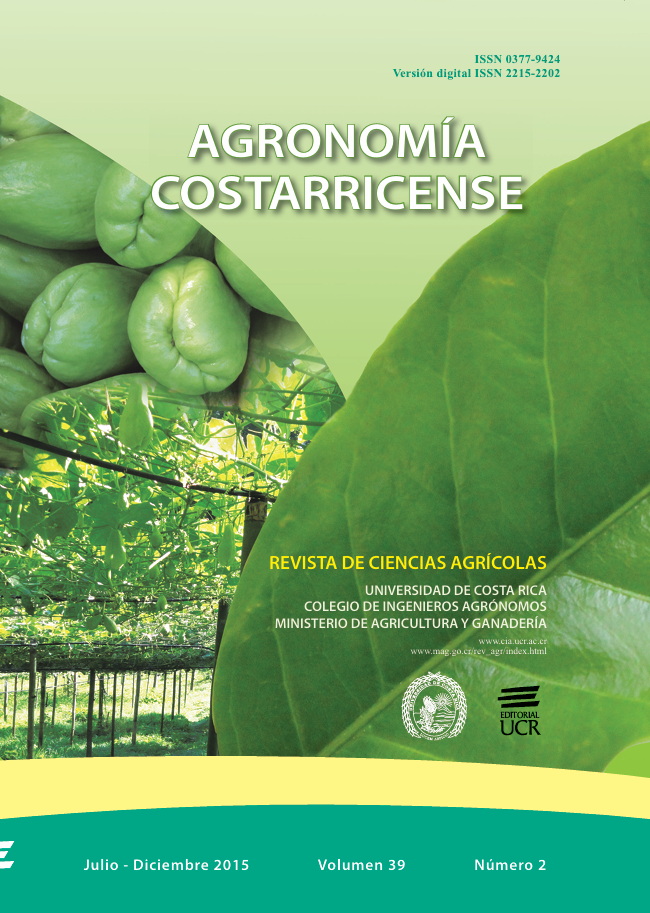Abstract
The effect of indolebutyric acid concentration (0, 500, 1000 or 1500 ppm), the position of the cutting on the parent branch (basal, medial or terminal), the cuttings size (6, 10 or 14 cm), the absence or presence of leaves, and the type of substrate (river sand, coconut fiber or carbonized rice husks) on rooting of bluebush under protected environment, were evaluated. The variables were the percentage and number of buds sprouting, rooting percentage and number and length of roots. Terminal cuttings presented the highest values for all variables, except for percentage of rooting: more outbreaks (17.5), length (0.17) and number of roots (0.65) than medial and medial cuttings, which would be associated with higher speed of rooting. The highest IBA doses (1000 and 1500 ppm) induced more roots per cutting (8.40 and 9.24, respectively) than lower concentrations. There was a higher percentage of rooting with IBA at 1000 ppm (69%) than without that compound (41%). Furthermore, use of leafless cuttings led to an increase in the magnitude of each of those variables. Higher bud sprouting (96%), rooting (92%) and root length (5.1 cm) values were obtained by using river sand than with any other substrate. Cuttings of 14 cm showed consistently higher number of shoots (3.71), longer roots (3.56 cm) and in greater numbers (10.71) than the smaller ones (10 and 6 cm).References
ALVARADO M.A., SOLANO J.A. 2002. Producción de sustratos para viveros. OIRSA. Costa Rica. 47 p.
ÁLVAREZ J.G., LUSARDO S., CHACON E. 2007. Efecto de diferentes tamaños de esqueje y sustratos en la propagación del romero (Rosmarinus officinalis L.) Agronomía Colombiana 25(2):17-18.
DI RIENZO J., CASANOVES F., BALZARINI M., GONZALEZ L., TABLADA M., ROBLEDO C. 2013. InfoStat, versión 2013. Grupo InfoStat, FCA, Universidad Nacional de Córdoba, Argentina.
DÍAZ E. 1991. Técnicas de enraizado de estacas juveniles de Cedrela odorata L. y Gmelina arborea Linn. Tesis de Magister Scientiae, Centro Agronómico Tropical de Investigación y Enseñanza, Turrialba, Costa Rica. 93 p
DOLE J.M., HAMRICK D.J. 2006. Propagation Basics, pp. 3-16. In: J.M. Dole and J.L. Gibson (eds). Cutting propagation: A guide to propagation and producing floriculture crops. Ball Publishing. Batavia, Illinois,
USA. GUTIÉRREZ N., DÍAZ S., YEOMANS J., HERNÁNDEZ C. 2006. Manual de tintes de origen natural para papel con fibra de pinzote de banano. Tierra Tropical 2(1):A1-A30.
HARTMANN H.T., KESTER D.E., DAVIES F.T., GENEVE R.L. 2011. Hartmann & Kester’s Plant propagation: principles and practices. 8 ed. Prentice Hall. 915 p.
LOACH K. 1988. Water relations and adventitious rooting, pp. 102-116. In: T.D. Davis, B.E. Haussing and N.B. Sankla (eds.). Adventitious root formation in cuttings. Porhand, Or, E.E.U.U., Disocorides Press.
LÓPEZ F.J., GUÍO N.R., FISCHER G., MIRANDA D. 2008. Propagación de uchuva (Physalis peruviana L.) mediante diferentes tipos de esquejes y sustratos. Revista Facultad Nacional de Agronomía Medellín 61(1):4347-4357.
MESÉN F. 1998. Enraizamiento de estacas juveniles de especies forestales: uso de propagadores de subirrigación. CATIE, Turrialba, Costa Rica. 36 p.
OCAMPO R.A. 1987. El uso de algunas plantas medicinales en Costa Rica. Litografía e Imprenta LIL, S.A., San José, Costa Rica. 100 p.
OCAMPO R.A., VALVERDE R. 2000. Manual de cultivo y conservación de plantas medicinales. TRAMIL, San José, Costa Rica. 148 p.
POP T.I., PAMFIL D., BELLINI C. 2011. Auxin control in the formation of adventitious roots. Notulae Botanicae Horti Agrobotanici Cluj-Napoca 39(1):307-316.
QUESADA G., MÉNDEZ C. 2005. Análisis fisicoquímico de materias primas y sustratos de uso potencial en almácigos de hortalizas. Revista Agricultura Tropical 35:1-13.
RODRÍGUEZ H. 2006. La utilidad de las plantas medicinales en Costa Rica. EUNA, Heredia, Costa Rica. 213 p.
RUIZ H., MESÉN F. 2010. Efecto del ácido indolbutírico y tipo de estaquilla en el enraizamiento de sacha inchi (Plukenetia volubilis L.). Agronomía Costarricense 34(2):259-267.
RUIZ R., VARGAS J.J., CENITA V.M., VILLEGAS Á. 2005. Efecto del ácido indolbutírico (AIB) y tipo de estaca en el enraizado de Gmelina arbórea Roxb. Revista Fitotecnia Mexicana 28(4):319-326.
THOMPSON E. 2009. Tintes tradicionales para colorear papel. Revista Herencia 22(1):79-87.
TREJOS E. 1996. Propagación de Vochysia guatemalensis por medio de estacas. Tesis de licenciatura. Universidad de Costa Rica, San José. Costa Rica. 57 p.
VIGNOLO G.K., DE OLIVEIRA D.L., FERNANDES V., JESKE R.,CORREA L.E. 2012. Enraizamento de estacas lenhosas de três cultivares de mirtileiro com diferentes concentrações de AIB. Ciência Rural, Santa María 42(5):795-800.
WHIPKER B.E., GIBSON J.L., CERVENY C.B. 2006. Rooting hormones and plant growth regulators, 89-99 pp. In: J.M. Dole and J.L. Gibson (eds.). Cutting propagation: A guide to propagation and producing floriculture crops. Ball Publishing. Batavia, Illinois, USA.
ZANONI C.A. 1975. Propagación vegetativa por estacas de ocho especies forestales. Tesis de maestría, Universidad de Costa Rica, Turrialba, Costa Rica. 100 p.
Comments

This work is licensed under a Creative Commons Attribution-NonCommercial-NoDerivatives 4.0 International License.
Copyright (c) 2016 Agronomía Costarricense


